Does public speaking scare the living daylights out of you? 👻 Join the club.
Facing a massive audience, expected to deliver an inspiring speech is terrifying to most people. And I’m right there with you.
I was mortified of public speaking but in 2011 I challenged myself to conquer my fear of public speaking and get out there. That year I spoke to 50 people at my first industry event. Many other conferences and 500+ webinars followed.
These days I’m still nervous every time but actually enjoy speaking and get a gratifying high out of it.
Overcoming your own public speaking anxiety starts with simply breaking down and listing what specifically you’re afraid of. Some common ones:
- Looking like a fool
- The audience not getting value
- People getting up to leave
- Blanking on what’s next
- Boring the audience
- Everyone noticing how nervous you are
In this post, we’ll logically refute those fears one by one. Everything I’ll touch on is focused on increasing your confidence. I’ve found that solid preparation is one of the keys to managing anxiety, so I start there.
If all you’re looking for are tips on last-minute stress management, you can skip ahead to “Delivering your Speech”. Otherwise, I recommend you start from the beginning.
I’ve broken the post down into three parts that mirror the sequence of first preparing and then delivering your speech
- Part one talks about the topic and content of the presentation, ensuring you deliver with conviction.
- The second part has some handy tips on how to design your presentation for maximum impact and how those visual cues will help you stay on track.
- The last part then shows you how to conquer your fear and deliver a speech that will wow your audience.
Part I - Preparing Your Content
Understanding Your Audience
Knowing your audience is hooked on your topic is a great confidence booster. So when you start preparing for a presentation the first thing to ask yourself is who your audience is and what they care about.
You can keep this super simple and just answer three basic questions:
- What is their job title?
- What are their top 5 challenges?
- Is their style formal or informal?
Combine this with insights from a survey my team and I ran to understand what motivates business people to consume content and you’ve got a magnetic topic.
In a previous role my team and I surveyed over 3,000 professionals. Here are the top three motivators they named for consuming business content:
- Learning new skills
- Staying up-to-date with industry trends
- Getting fresh ideas
Now take the top challenges you identified and find an angle to either teach them a new skill, share a perspective on a hot industry trend, or share your best hacks.
Since this post is focused on public speaking anxiety I won’t go into detail here, but check out this “Primer on how to identify a great topic for your next talk” for more.
Talk About Something You Love
Here’s the kicker, though: a presentation topic you know your audience is thirsty for is not enough to get you brimming with confidence.
You need to also be competent in the subject matter and better yet have a true passion for it. If you’re both competent and passionate you’ve won half the battle. That combination is unlikely to fail.
People will feel that passion in your presentation and it will be easier for them to make an emotional connection to you. And talking about something you love will naturally make you feel more at ease.
If you absolutely have to speak about a topic you know little about, I recommend you spend at least a few weeks on improving your knowledge. Knowing the subject matter by heart will increase your chances of engaging your audience and will make it easier for you to regain your composure if something goes wrong.
Great. Now that you know your stuff, the likelihood of looking like an utter fool has just decreased 10-fold. There goes fear number one.
Looking like a fool- People not getting value
- People getting up to leave
- Blanking on what’s next
- Boring the audience
- People noticing how nervous you are
Be Clear on What You Want to Convey
Once you know the theme of your presentation you will need to get clarity on what exactly it is you want to convey. These questions will help.
- What constitutes the heart of the matter from your perspective?
- What are common misconceptions that need to be put right?
- What important fact is often overlooked?
Your guiding principle for answering these questions should again be your audience: What’s in it for them? What do they stand to gain from what you have to say?
Now try to formulate the answer in a concise, benefit-oriented statement. This statement will be your guide to fleshing out your presentation.
Keep the scope limited to one to three big ideas. A focused presentation will resonate better.
Get this right and your audience will get value and stay engaged. You can then feed off that engagement and energy during your talk.
That should deal with your worry that people will hate your presentation or get up to leave.
Looking like a foolPeople not getting valuePeople getting up to leave- Blanking on what’s next
- Boring the audience
- People noticing how nervous you are
Map Your Content
With your content statement at hand, you are ready to develop your content.
There are many techniques for building your content outline. Many presenters swear by analog methods and recommend you start planning with pen and paper or on a whiteboard.
Personally, I prefer to start digital, but the way you structure your thoughts is up to you and I encourage you to explore to see what works best.
Create a Logical Structure
No matter which technique you use, the goal is always the same: A clear and logical structure that listeners will easily be able to follow.
A simple blueprint you’ll frequently see recommended by public speaking coaches comes from a turn of the century preacher.
His advice: Tell them what you are going to tell them, tell them why they should listen, tell them, then tell them what you just told them.
Tell them what you’re going to tell them
Give a two-sentence summary of what your talk is about so the audience knows they’ve come to the right place.
Tell them why they should listen
This is a great way to get your audience to commit and engage. What will their main benefit be from listening to you?
Tell them
The main content of your presentation.
Tell them what you told them
Conclude with a quick recap of your key points.
I’ve built a presentation template you can use to implement this blueprint.
Another good way to create a logical structure for your presentation is to tell a story, but I’ll leave tips on storytelling to Brian Peters.
I’ve created a slide template that follows the pattern above. Feel free to use it as an outline for your next presentation.
A Blueprint for high-impact Webinars
- Layouts specifically made for webinars
- Easy to edit & adapt
- Add your custom color scheme & logo
- Over 50 layouts included
- Follows the tell/tell/told blueprint
- Includes hook & call-to-action layout

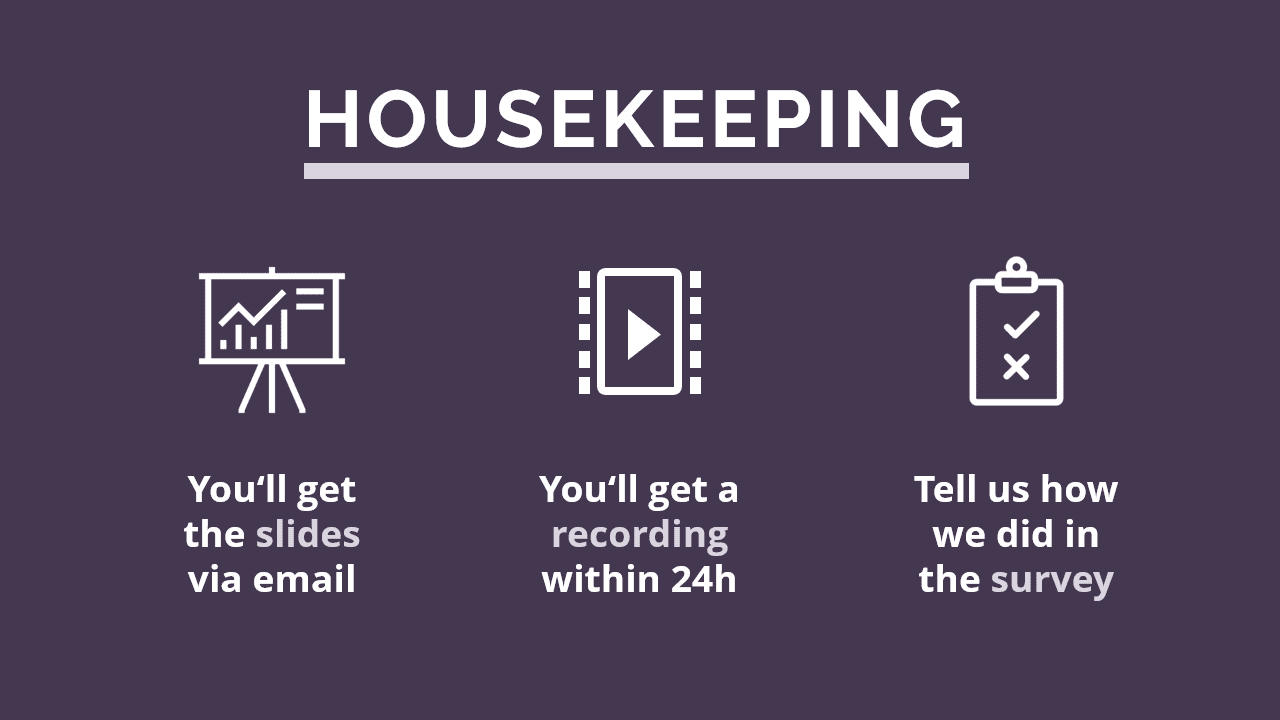


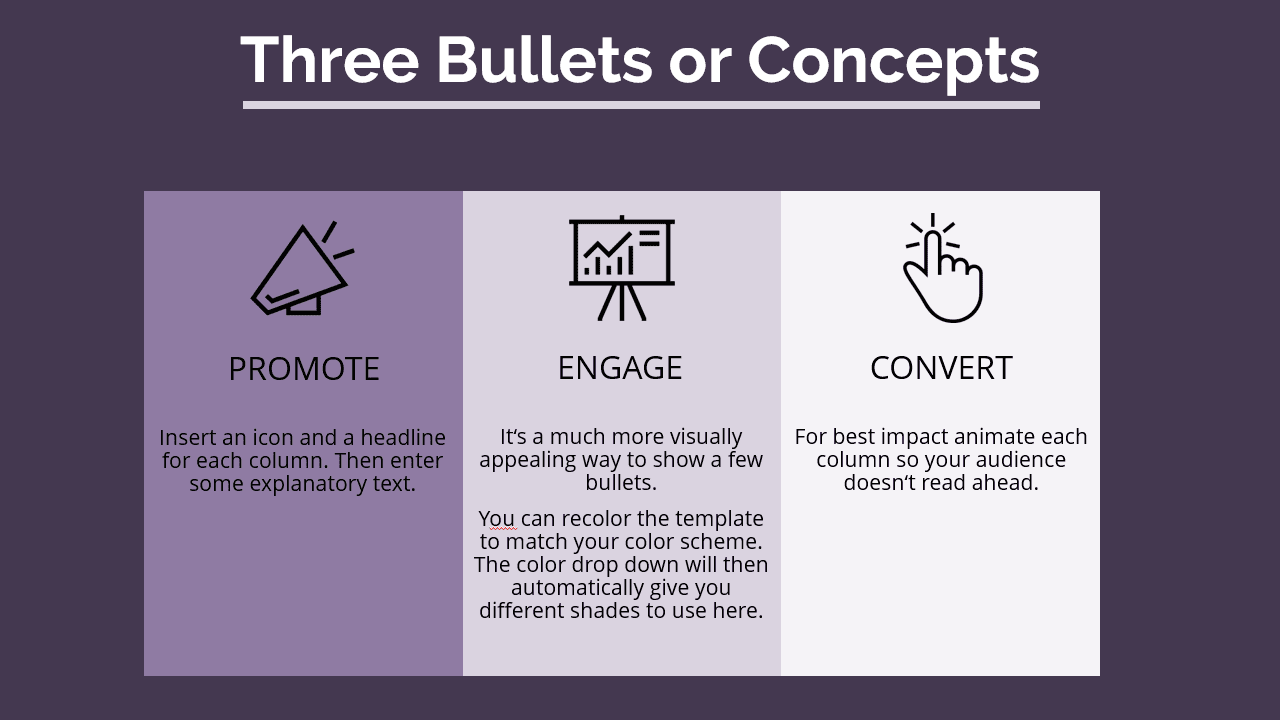
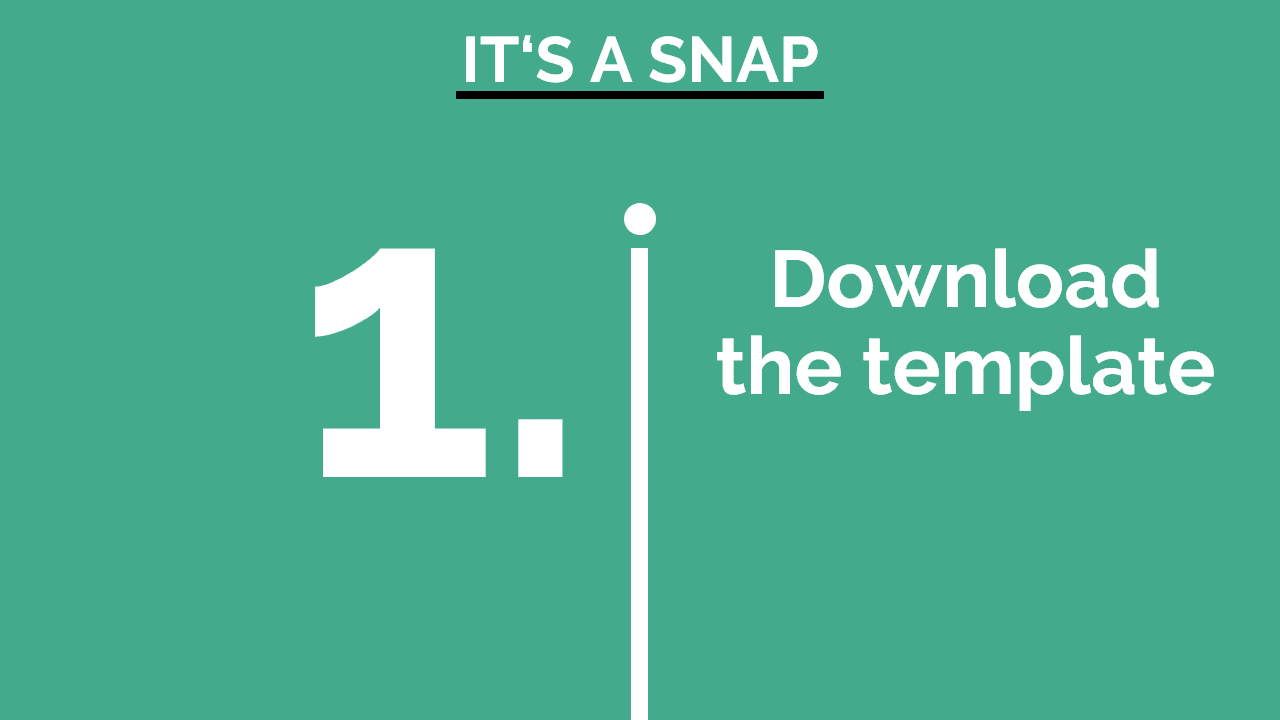
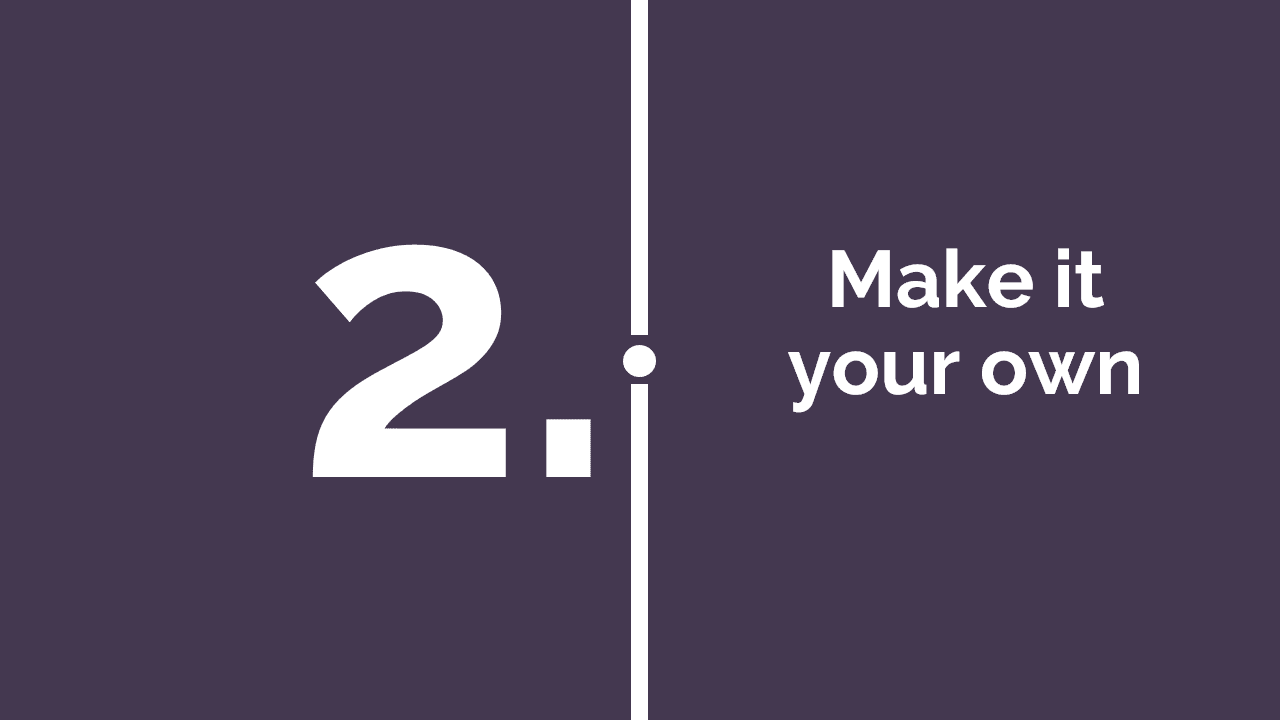



Subscribe to my newsletter to get free webinar tips & updates and get instant access to the template.
I never send spam & you can unsubscribe anytime. See the terms & privacy policy here.
Part II - Designing Your Presentation
Images - They Do Say More
You know the proverb, so I won’t repeat it here. I’ll just say that high impact images are the backbone of your presentation design and will make you visually stand out from the crowd.
You don’t need to be a design wizard either. All you need is a beautiful image and a simple headline.
Try to illustrate all major parts of your presentation with high-resolution images that fill the whole slide. Yes, the whole slide.
You will need to find an image that is a close match to what you want to say. Sometimes that requires some thinking around the corner. Write down the concept you’re trying to illustrate, then do some free association to come up with ideas. Here are a few examples from my own talks:






Images Help Jolt Your Memory
The unexpected benefits of using images in this way are that they give you a visual cue that jolts your memory. If you lose your train of thought the image will help you get back on track.
That should deal with your angst of blanking on what’s next.
Looking like a foolPeople not getting valuePeople getting up to leaveBlanking on what’s next- Boring the audience
- People noticing how nervous you are
Keep Your Slides Clean
In the examples above you might have noticed that there is not much else visible beside the image, and these are not transition slides.
Using just a few words per slide is a conscious decision to avoid clutter. You should go out of your way to keep your slides clean. Less is more in that regard and the clean look will help keep your speech focused.
It will also help you avoid a familiar presentation pitfall: Death by Powerpoint. Check out this hilarious video by Don McMillan to see what that’s all about.
People Read Faster Than You Can Present
I admit that a few words per slide will not cut it in all possible situations. If you absolutely have to have more text, try to use as little of it as you think you can get away with.
Keep too much text on your slides and nobody in the room will hear a thing you say. They’ll all be busy reading. They’ll also be finished reading the content long before you have finished presenting it.
Time they will happily use to do something else, like check email or their Twitter feed – and looking up to see your audience intently staring at their phone can be a real downer and increase your anxiety.
Use Large Font
The headline really says it all. If you heed the tips about the use of big images and minimal copy you will find yourself with a lot of white space on your slides.
The best way to make use of that space is to make the little text you have large enough so that everyone in the room will be able to easily read it.
Experts like Guy Kawasaki and Garr Reynolds recommend 30 points or larger.
I’ve experimented with this on one of my webinars and shown viewers copy in different font sizes to ask them what size felt most comfortable. The sizes the majority picked started at 42 pts or even larger.
Get a Bird's Eye View
Once you have your content structured and your slides laid out, you should take a moment to look at the big picture. Use the slide sorter view in Powerpoint to get an overview of the flow of your slide deck.
- Does the structure still make sense to you?
- Does every slide have a point?
- This is also the opportunity to get a friend, colleague or significant other to review your presentation. Do they understand the structure? What do they remember after having seen the slides once?
Ruthlessly eliminate anything that doesn’t provide value to your audience. A higher concentration of value in your speech will always lead to a better reaction from your listeners – in turn creating a positive feedback loop.
You highly visual slides will look great on the big screen and your one idea per slide approach will make it easy for attendees to understand what you’re on about. Boredom unlikely.
And just like that, we’ve ticked off another item on our fear list: Boring the audience.
Looking like a foolPeople not getting valuePeople getting up to leaveBlanking on what’s nextBoring the audience- People noticing how nervous you are
Part III - Delivering Your Speech
Practice, Practice, Practice
When I prepped for my first big speech I read up on presenting. I was blown away when I learned Steve Jobs rehearsed his presentations weeks in advance and two days straight leading up to the event.
If Steve Jobs managed to get that into his undoubtedly super-busy schedule, what was my excuse for not being able to? And more to the point: What is yours?
Confidence is the key to delivering a great presentation and the best way to gain confidence is practice. With your slides ready, do a dry-run of your presentation.
Vocalize the words as if you were already on stage. Listening to your own voice you will immediately notice the weak spots in your delivery.
There is really no limit as to how often you should practice your presentation. I aim for 5-10 times depending on the importance of the event. In the end, simply rely on your own judgment and practice until you feel confident.
With your confidence up from hours of practice and your delivery sounding natural and relaxed you’ve just conquered another fear: People noticing how nervous you are.
Looking like a foolPeople not getting valuePeople getting up to leaveBlanking on what’s nextBoring the audiencePeople noticing how nervous you are
Good Habits for the Day You Present
I always curse myself when I realize too late that I’ve broken with one of my good habits on the day of the presentation. They may not be groundbreaking, but ignore at your own risk:
No coffee!
Some of coffee’s side effects according to WebMD: Nervousness, restlessness, increased heart rate, anxiety, etc. Do you need to know more?
No carbonated drinks
Want to spend 40 minutes trying to burp away from your microphone? Me neither.
Have some water ready
A glass of still water is a great accessory for any speech. It makes your voice supple and taking a sip is a great opportunity to pause and pace yourself.
Right Before the Presentation
The time is here. You’re on. These tips will help you ease into it:
- Develop a calming habit. What works for me is to use the coffee break before my presentation slot is up to go on stage and have a look at the auditorium. That way I feel less exposed when the room fills again.
- Stretch your legs. Walk a few steps. It’ll ease the tension.
- Pull some weird faces before you go up on stage. Relaxed facial muscles improve your pronunciation.
- Babble like a baby. It will loosen up your voice making it less likely that listeners detect your nervousness. You’ll also feel quite silly, and silly is much better than tense 😉
Try some power poses. Researcher Amy Cuddy found our body language can shape how we feel.
Ever needed to feel powerful? Like right before going on stage to talk to hundreds or thousands of people? Exactly! So try these:
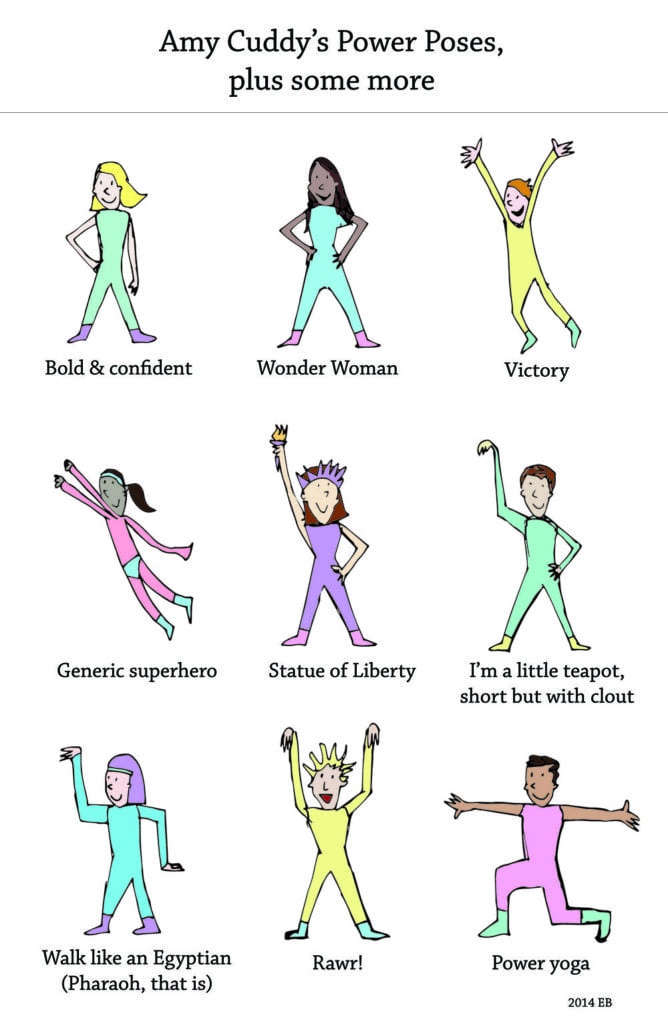
The First Impression Counts
Make an effort to craft a strong opening to your speech. I find the first moment is the hardest, so I spend extra time rearranging words and sentences until they feel just right.
It all ties back to confidence. If you’ve rehearsed well your confidence is up and that shows when you present. A smooth opening. No awkward pauses.
Best of all: Feeling secure about the opening line takes away much of the nervousness immediately before you go on stage. And once you’re past your first sentence you’re in the flow. Oh, and having professional webinar equipment that makes you look like a rockstar helps too 😉
Smile!
Always remember that a positive attitude is contagious. Make eye contact with individuals within your audience and smile. They’ll smile back, reinforcing your confidence and creating a positive atmosphere.
Conclude with a Conclusion
Concluding with a conclusion sounds obvious, but many presentations simply end. Usually to be followed by Q&A.
This is possibly the biggest missed opportunity in public speaking. If you want the audience to remember you and your speech, you need to repeat the key takeaways from your presentation before you end with a simple “Thank you” and a slide listing your contact info.
Public Speaking Anxiety? You've got this!
That’s it. You’ve logically refuted the most common fears and you’ve got a magnetic topic and stellar content.
Lastly, remember that the audience wants you to succeed. They were attracted to your topic and are now rooting for you. You’ve prepared well and are (now) a true expert. You’ve rehearsed like your life depended on it and have a strong opening ready.
You’ve got this!
So What's Next for You?
What’s your story? Do you have a presentation coming up? What are you afraid of most? How do you cope? Let me know in the comments below.


